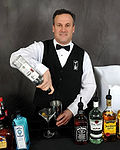Soda siphon

The soda siphon (sometimes spelled syphon), also known as the seltzer bottle, siphon seltzer bottle, or just siphon) is a device for storing and dispensing carbonated beverages (typically carbonated water) while maintaining the internal pressure, thereby preventing it from going flat. The carbonated beverage is dispensed using the internal pressure of the bottle, so the setup is not a true siphon in its operation.
History
[edit]
As early as 1790, the concept of an "aerosol" was introduced in France, with self-pressurized carbonated beverages.[1] The modern siphon was created in 1829, when two Frenchmen patented a hollow corkscrew which could be inserted into a soda bottle and, by use of a valve, allowed a portion of the contents to be dispensed while maintaining the pressure on the inside of the bottle and preventing the remaining soda from going flat.[2]
Soda siphons were popular in the 1920s and 1930s. The rise of bottled carbonated beverages and the destruction of many of the siphon manufacturers' plants in Eastern Europe during World War II led to a decline in their popularity in the years after the war.[2]
21st century production
[edit]
Commercial production and delivery of pre-filled bottles of seltzer continued in the Southern California and Eastern Seaboard regions of the US into 2009.[3]
See also
[edit]- Soda machine (home appliance)
- Carbonated water
- Carbonation
- Gasogene
- Whipping siphon, for making whipped cream with compressed gas
References
[edit]- ^ Donald A. Bull (2001). "Cork Ejectors". Archived from the original on 2006-07-09. Retrieved 2006-09-13.
- ^ a b Bryan Grapentine (May 1998). "Seltzer Bottles" (PDF). Bottles & Extras. Archived from the original (PDF) on 21 October 2006. Retrieved 2006-09-13.
- ^ Corey Kilgannon (2009). "Seltzer Man Is Out of Action, and Brooklyn Thirsts". The New York Times. Retrieved 2009-09-26.

